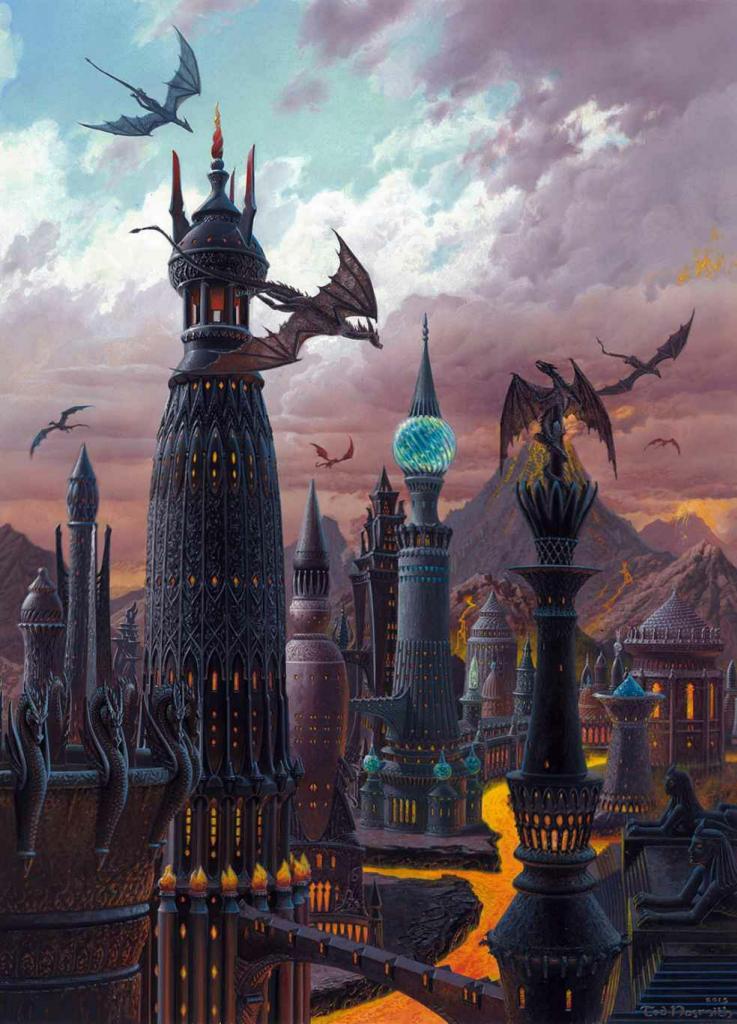In the beginning of House of the Dragon E2, King Viserys gives a brief history lesson on Valyria, here is a deeper dive into the story.
House of the Dragon Episode 2 SPOILERS
House of the Dragon Episode 2 starts with a gruesome scene of the Crabfeeder at work before transitioning to a tense Small Council scene that leads to Princess Rhaenyra choosing a new member of the Kingsguard.
The next scene features King Viserys speaking with Alicent Hightower while poring over sculptures of the cities of Old Valyria. Within this conversation is one of the most significant lore dumps on the Valyrian Empire in Game of Thrones or House of the Dragon to date.
In the Game of Thrones universe, Valyria is akin to the Roman Empire— a hegemonic power of the world that ruled without contest. As King Viserys explains, it is this kingdom that the Targeryens hail from.
Even with the exposition given by Viserys, there is still a chunk of information left out. The job of this article is to expand on each of the aspects of Valyria that Viserys touched on.
The Valyrian Capital
Valyria is both the name of the empire and the name of the empire’s capital. Valyria was located on the southern tip of the Valyrian Peninsula before it was destroyed and was connected to the rest of the Valyrian Freehold.
Multiple times after the Doom of Valyria, various parties attempted to reclaim the capital. All of them vanished without a trace.
The Dragonlords of Valyria
Valyria was ruled by around 40 ‘Dragonlord’ families, the Targaryens were also dragonlords but were not considered to be of prominent stature.
The dragonlords used powerful sorcery to tame their dragons. They were said to use binding spells and horns, which granted them far more control over the dragons than the Targaryens ever had during their dynasty.
Dragonlords were said to be inhumanely beautiful, with blonde or platinum hair and lilac, purple, and pale blue eyes. The dragonlords of Valyria often wed brother to sister, as the Targaryens continued to do after them.
Almost all of the dragonlords died during the Doom of Valyria.
Valyrian volcanoes
The volcanoes located on the Valyrian peninsula were known as The Fourteen Flames. They were controlled by fire mages who used them to conduct magic for the Valyrian Freehold.
On the day of The Doom of Valyria, every hill for five hundred miles burst to pieces in an explosion of magma. The eruption filled the air with ash, smoke, and fire, which killed even the dragons.
Earthquakes decimated much of the Valyrian architecture and lakes in the area boiled or turned to acid. Islands to the East of the peninsula were swamped by tsunamis that left few survivors.
Following the mass eruption, the peninsula itself was shattered into smaller islands and the area would become severely tainted by the ecological disaster.
Anogrion and the Bloodmages
Both blood and fire magic were used in Old Valyria to create and maintain control over both dragons and the Fourteen Flames.
These two magics types were practiced by blood mages and fire mages respectively and while there was overlap, these mages were not exclusively from dragonlord families.
Septon Barth of Westeros speculated that these mages used wyverns (massive, wingless reptiles found in volcanoes) as a base to create dragons.
The Anogrion appears to be a concept that originates from the show, as there is no mention of it in the preexisting material.
Valryia’s rise and fall
Valyria was said to start as a humble nation of shepherds who discovered dragons within the fourteen flames. There are also those from Asshai who said the dragons were brought from their country to Valyria.
Regardless of where they came from, the dragons were soon tamed and were then used as weapons of war to expand the influence and territory of Valyria.
The empire of dragons and dragonriders began its expansion roughly 5,000 years before the events of Game of Thrones, and saw calamity 100 years before Aegon I Targaryen’s conquest of Westeros.

































